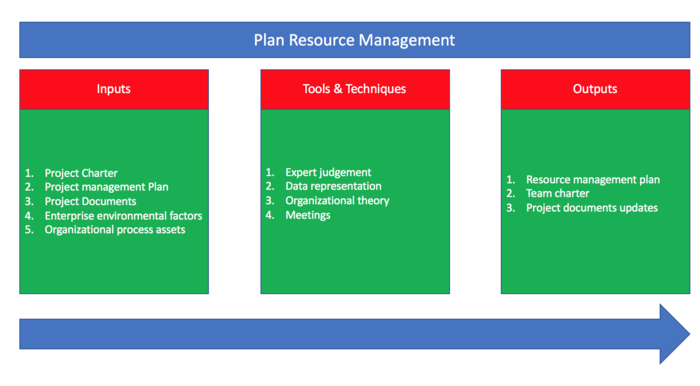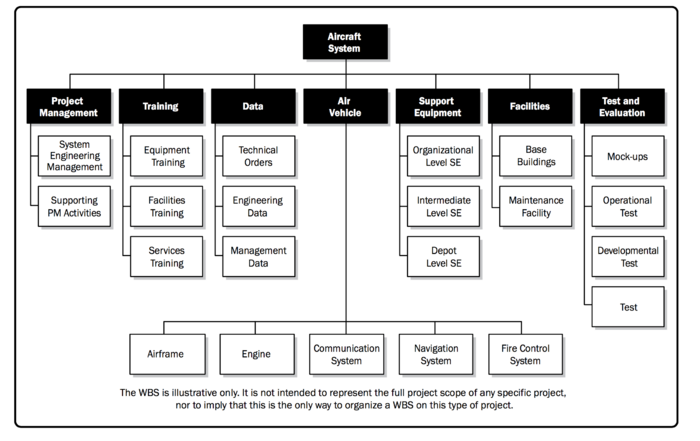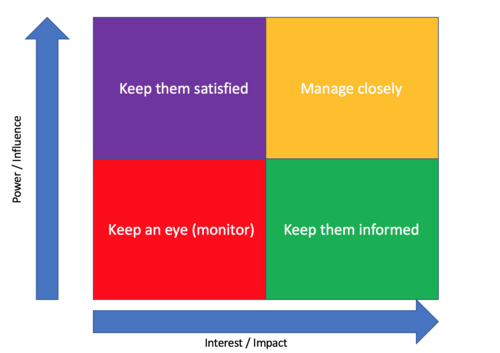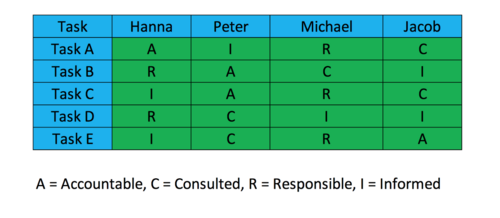Resources in Project Management
(→Structure of article) |
(→Enterprise Environmental Factors) |
||
| Line 135: | Line 135: | ||
===Enterprise Environmental Factors === | ===Enterprise Environmental Factors === | ||
| − | The environment is basically always fluctuating. The environment can be defined as anything which belongs to the natural world and is more or less uncontrollable. EEF is a condition that controls the project but as a project | + | The environment is basically always fluctuating. The environment can be defined as anything which belongs to the natural world and is more or less uncontrollable. EEF is a condition that controls the project but as a project manager you don't have control over the EEF. The environment does affect a project both positively and negatively. In environment one can distinguish between external and internal environment. |
| − | + | ||
| − | + | ||
| − | + | ||
External: | External: | ||
| − | * Government regulation | + | * '''Government regulation''' |
| − | * Market conditions | + | * '''Market conditions''' |
| − | * Infrastructure | + | * '''Infrastructure''' |
| − | * External political Condition | + | * '''External political Condition''' |
Internal: | Internal: | ||
| − | * Organizational culture | + | * '''Organizational culture''' |
| − | * Types of organizational structure | + | * '''Types of organizational structure''' |
| − | * Internal political conditions | + | * '''Internal political conditions''' |
| − | * Available resources | + | * '''Available resources''' |
| + | |||
| + | Above are some of the internal and external points. For instance the government can increase the taxes and it would make the project team forced to revise their project plan, budget etc. There can also be | ||
===Organizational Process Assets === | ===Organizational Process Assets === | ||
Revision as of 19:56, 22 February 2019
Developed by Hedin Gunnarsstein Poulsen - s153658
Contents |
Abstract
Resources are an important aspect of everyday life. Resources are what you have available to complete a task and get an output. In a project management perspective, resources can be anything from time, money, people, facilities and equipment. Proper resource management is important in this matter, as it must ensure that people are not overloaded with work, and that time is effectively utilized, as well as the final budget must be within or under budget. Often in resource planning, the challenge is to find a baseline and complete the projects on time and to budget. Statistics however shows that one in every three project have no baseline[1] and less than one-third of projects are completed on time and on budget[2]. These are just a few examples of how difficult resource management planning can be. Resource management planning could for instance help project managers and project team to solve and answer questions like:
- Do we have enough space on our budget for new equipment and experts handling this products? What if not?
- Is there anyone who is overloaded with work and is there anyone who has not sufficient amount of work?
- Is there any worker available to work in the Christmas holidays?
- How will adding another project affect the existing projects?
- Is the project on time?
To make sure the right resources are available for the project managers and project team at the right time there has been developed Project Resource Management processes/tools[3], to identify, acquire and manage the resources for a successful completed project. This article will focus on the following processes:
- Plan Resource Management
- Estimating Activity Resources
- Acquire Resources
- Develop Team
- Manage Team
- Control Resources
In this article the focus will be on the process of Plan Resource Management
Structure of article
This article is built around the Plan Resource management model described in the next chapter. The article will be built on the input points and with those input points there will be proposed some tools & equipments to move the input over to output. Throughout the article there are several supporting figures to make the description more visually clear and understandable. The article ends with a summary and conclusion.
Plan Resource Management
Plan Resource Management is a process to estimate, acquire, manage, and use team and physical resources. The key benefit of this process is that it establishes the approach and level of management effort needed for managing project resources based on the type and complexity of the project.
Plan Resource management is used to ensure that the resources are sufficient and available during the project time and thereby making sure that there is a successful completion of the project. Those resources can be found internally and also outside of the organization through a procurement process. In this article there will be looked out how the elements inside the boxes: Inputs, Tool & Techniques and Outputs are defined and also some methods to get this information which is needed for the output. The structure of the explanation will be based on PMO theory.
Project Charter
Project charter is probably one of the most confusing areas in the project and it begins prior to project being even started It is also arguable that is the most important part of the project as it outlines the whole project and more or less will choose the outcome of the project. It is an agreement between contractors and other people. In the project charter the project name is identified. There will be outlined that it is a formal authorization document for the description of the project. So the description of the project states the need, that this project is going to provide a solution for the organization. It states the organization, the need that the organization has, and the solution that this project is deemed to fit. The project charter also includes key stakeholder list, summary milestones, costs, preapproved financial resources and also the risk assessment which is attached to the project which are vital for the survival of the project. A Project charter should include, according to PMO atleast these topics:
- Requirements
- Business Needs
- Summary Schedule
- Assumptions and constraints
- Business case, including return on investment
Project Management Plan
The Project management plan consists of two elements: Quality management plan and scope baseline.
Quality Management Plan
Project management quality plan is implemented to ensure that acceptance of quality is agreed upon prior to project and to set a set of standards defined by the customers mostly but also stakeholders are involved, and it describes how the project will make sure to live up to these standards agreed upon. Quality management makes the possibility of meeting the required standards more realistic and makes sure that:
- Product is built up on prior agreements about the standards and expectation.
- Work efficiency is going as planned and there is no delay
- If there is a conflict there will be taken action and the problem will be solved immediately
Normally in project management quality plan the Project Manager, Project Team, Customer and stakeholders are involved. According to PMO, the quality management plan can be divided in a three process.
- Plan Quality Management
- Perform Quality Assurance
- Control Quality.
These topics are already discussed in several wiki-articles. Press the link besides the bullet points for further interest on these topics.
Scope Basline
A scope baseline used to measure, manage, assessing and controlling the project scope. Scope baseline is a actually component of the project management plan. Scope baseline can be changed only through formal control procedures. It contains three elements of approved project documents:
- WBS (Work Breakdown Structure):
- WBS Dictionary
- Detailed Project scope statement
The detailed project scope statement includes the description of the project scope, deliverables, assumptions and constraints.
To make a picture of what the tool WBS is intuitively, one could take as an example that you can’t eat an elephant at once, you have to divide it up in pieces and eat one piece at the time to complete the task, or when you clean your room you have to make it in parts, maybe first clean up the floor and then wash it and afterwards vacuum the floor. So the concept behind WBS is very simple and is that every complex project task can be broken down to smaller task until you meet a point where this is not possible anymore. The work break down structure helps to visually see all the components that make up the task and ultimately make up the entire project. A typical WBS has around 3-6 levels.
The WBS dictionary is a more detailed part of the WBS about every element it may describe. It describes milestones, costs, deliverables, acceptance criteria, schedule etc. While WBS could be used for higher level manager, a WBS dictionary is more for the people involved in a certain sub-division area of the WBS like middle/project managers.
Project Documents
Project document is an overview of the whole project. That is the time schedule, the risk associated with different parts of the projects, who are the stakeholders and what influence do they have on the project and who is responsible for what, so that the project can succed.
Project Schedule
The project schedule shows how the activities are linked with planned dates, durations, milestones and resources. All project schedules have a start date and a end date. To control this companies and project teams are most often using Gantt Charts to represent schedule. To read more about Gantt charts press here: Gantt
Risk Register
To get an overview over what the risks are with the different parts of the project a risk-analysis is done. The risk is one two parameters, they are consequences and probability.
From the figure above there can be seen that a risk-analysis is a function of consequences. The risk-analysis is made in the following way:
- Brainstorming: What can go wrong?
- Asses the consequences high to low.
- Asses the probability that a certain part may happen.
- Calculate the final risk (probabiity x consequence).
- Come up with solutions that can reduce probability and consequences
Stakeholder Analysis
To identify the important stakeholders and their influence and interest in the project a stakeholder analysis can be used. Stakeholder analysis is a strong tool and is applied for getting more information about the stakeholder environment and to prioritise management resources. Stakeholders are the resources. Product, services we are delivering or people delivering to us, these are all stakeholders and by making a stakeholder analysis it is possible to align the stakeholders and make assesments.
The first step is for the management to identify the stakeholders. After all the stakeholders are listed they need to be listed in terms of power and interest. This for getting information about the influence the stakeholder has on the project. The influence/interest table can be listed in 4 boxed and are described in the following:
- Manage closely : These stakeholders have high interest and influence. These are the most important stakeholders. It is extremly important to keep them satisfied. Keep them updated all the time, make them involved in decisions and always find out what is important to them and help them out.
- Keep them satisfied: These stakeholders have high power but very little interest. As these stakeholders are very powerful the main goal is to increase their interest by inviting them for meeting and asking them all the time. They can cancel resources at any time, so they need to be under the monitor all the time and try to move them to the box “Manage Closely”.
- Keep an eye: These stakeholders are not that powerful and have little or no interest in the company. The goal is therefore to keep an eye on them and try to increase their interest for the project as they could move to another position in the future.
- Keep Them informed: These stakeholders are mostly external. These people have very low power and very high interest in the project. This group should always be informed as these stakeholders often can be very helpful with consultancy for the project.
Responsibility Chart
It is not sufficient to only have some inputs. There also have to be some tools/equipment for making sure the project parts are being implemented. The Responsibility chart is a useful tool as it is firstly clarifying which person has which role and responsibility and also secondly that it is a great way to..
- Responsible: The one who is completing and delivering the task. This person may get assisted during the process.
- Accountable: This person is the authority aspect of the project. The main goal is to approve the work the responsible has done. Only one accountable can be set for each action
- Consulted: These are the consultants. These are often specialized people and experts who know a lot about one thing and are consulted before taking a decision. Input from this people is necessary. This is mostly a two-way communication system.
- Informed: These are people who need to be informed when a decision is taken. This is mostly a one way communication
Enterprise Environmental Factors (EEF) and Organizational Process Assets (OPA)
Enterprise Environmental Factors
The environment is basically always fluctuating. The environment can be defined as anything which belongs to the natural world and is more or less uncontrollable. EEF is a condition that controls the project but as a project manager you don't have control over the EEF. The environment does affect a project both positively and negatively. In environment one can distinguish between external and internal environment.
External:
- Government regulation
- Market conditions
- Infrastructure
- External political Condition
Internal:
- Organizational culture
- Types of organizational structure
- Internal political conditions
- Available resources
Above are some of the internal and external points. For instance the government can increase the taxes and it would make the project team forced to revise their project plan, budget etc. There can also be
Organizational Process Assets
- Policies
- Procedures
- Standard template
- General guidelines
Conclusion and summary
During this article the focus has been on Resource project management. For each input there has been proposed a tool to make it possible to get an output.
The tools which were used were
Data Representation:
- WBS
- Risk-analysis
Annotated bibliography
Annotated figures
Figure 1 is from PMO
References
- ↑ [The State of Project Management, Annual Survey 2016, APM PMO specific group, page 7'] http://www.wellingtone.co.uk/wp-content/uploads/2016/01/The-State-of-Project-Management-Survey-2016.pdf
- ↑ [CHAOS MANIFESTO 2013, Think big, Act small, page 1'] https://www.versionone.com/assets/img/files/CHAOSManifesto2013.pdf'
- ↑ [Project Management Institute, (January 01, 2013), A Guide to the Project Management Body of Knowledge (PMBOK® Guide), Vol. 5, ISBN-13 978-1-935589-67-9, chapter 9']




